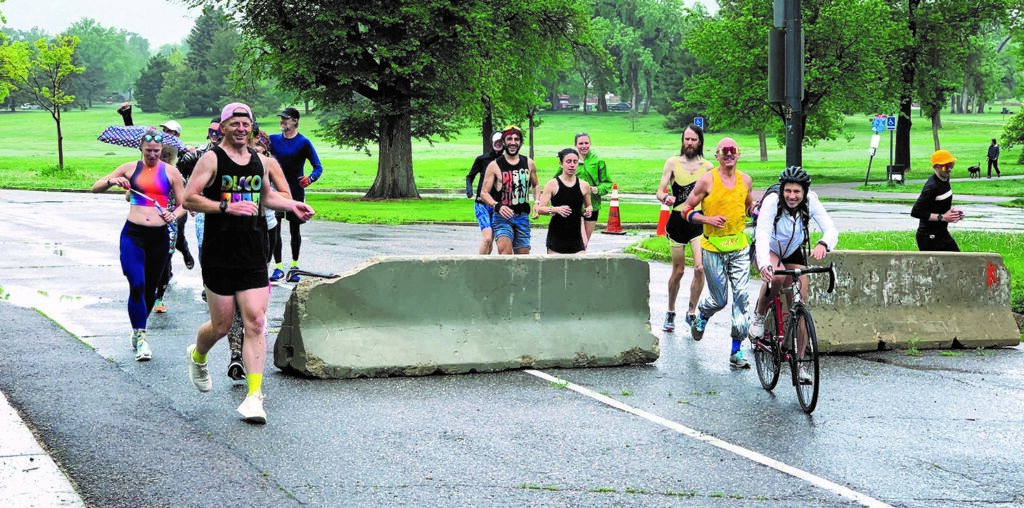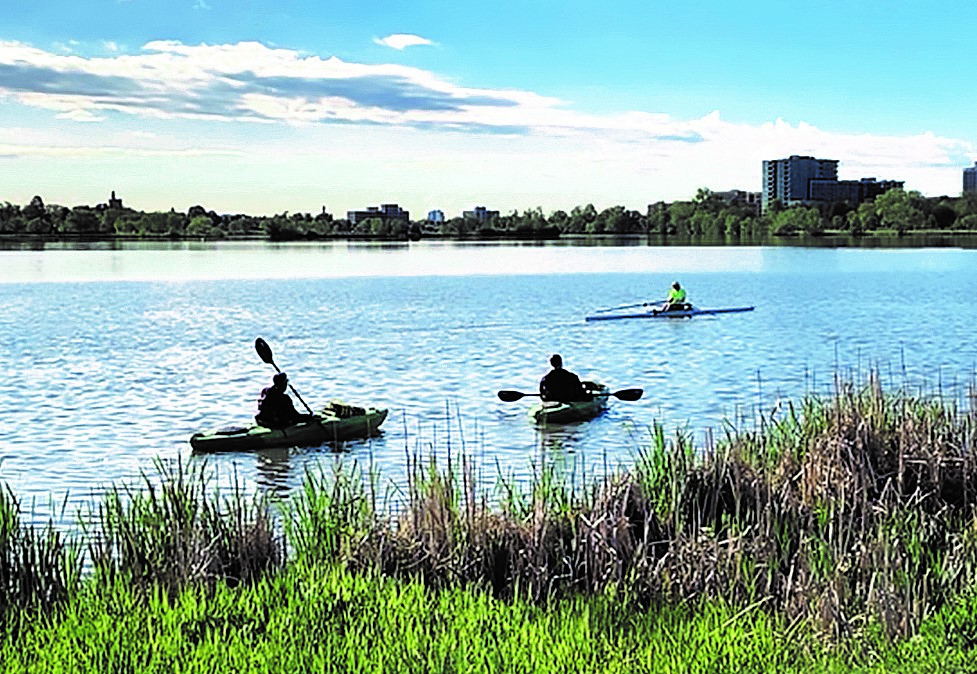
Changes seen in Sloan’s Lake Park that started with the pandemic in 2020, like a car-free Byron Place and Lakeshore Drive and a lake without power boats or sailboats, are evolving into more long term norms.
In the early days of the pandemic, Scott Gilmore, Deputy Executive Director with Denver Parks and Rec explained that “we just didn’t know how COVID was transmitting.” So the city focused on trying to protect people by limiting crowds in regional parks across town by shutting down parking lots and opening up the park streets exclusively to walkers, runners, and people on bikes by closing access to cars to allow more space for social distancing. They also shut down Sloan’s Lake to power boating and sailboats to eliminate the potential for groups to gather on larger boats.
Since then, Denver has relaxed many of those restrictions and started to open up the parks again. But Parks and Rec started to get feedback that people enjoyed some of the car-free streets,” so Parks started our own public input process on what people like to see” while taking accessibility issues into account.

In the case of Byron Place and Lakeshore Drive, Gilmore said, “Sloan’s Lake has always had Lakeshore Drive. We’ve always discussed that the road just serves as a cut-through through the park. That road goes through the park, but it’s not like it takes you to a playground, it doesn’t take you to the tennis courts, it doesn’t take you anywhere. That was a clear example of one of the roads in our system they felt could stay closed in the future. If there are activities or festivals that need to utilize that road, we can still do that.” Gilmore said that it’s a learning process for Parks and Rec and they continue to listen to community feedback, but he has not received a negative email about the streets being car-free in Sloan’s Lake and has received numerous emails of people appreciating the closure. He indicated that they will be looking for ways to improve the closures with more permanent gates or bollards to continue to allow maintenance and emergency access.
Yang Wang lives in Sloan’s Lake, and is one of those community members that has really been enjoying the closures. She appreciated them as a way to social distance in the early days of COVID, but more recently has enjoyed them for running with a stroller and also allowing them as a safe place for her toddler to learn how to bike. Wang ”really hopes Lakeshore Drive can be permanently car free; that would be wonderful.” She also finds the car-free street as a much safer and enjoyable way to commute into downtown for work than some of the neighborhood streets.

Gilmore has also indicated some new changes prohibiting powerboats and sailboats on Sloan’s Lake this year due to concerns around safety. “The lake is incredibly shallow, we all know that. Average depth is 3.5-4 ft., with some pockets of 6 feet. To be honest, it’s not deep enough for power boating.” Gilmore, an aquatic biologist, also noted that power boats were prohibited due to environmental concerns and they are doing a study this year on what the long term plan should be.
“From the research that consultants have told us, they actually say that motorboats could aggravate any situation of low oxygen, and heating the lake up would make a fish kill (like the Black Croppy fish kill that occurred last year) even worse. What happens when the sun is out, it is heating up the sediment that is suspended in the water. When a motor boat goes around the lake, the motor spins, and from studies it’s about 6 feet down it turns the water. The problem here is that the lake is not deep. So the boats skimming around the lake actually will turn up the sediments that are really close to the surface and will suspend those sediments in the water, which then the sun will heat up the sediments, which actually can heat up the lake even faster, which could create even worse fish die offs.” Parks and Rec is planning on putting floating Solarbee aeration devices on top of the water to have a more healthy circulation at the top of the lake that doesn’t stir up sediment and to help prevent toxic algae blooms.
Despite the powerboat and sailboat ban, Gilmore said Parks and Rec will allow hand-launched boats like canoes, kayaks, and paddle boards in the lake for free with no permits required. They will also allow the boats for the Dragon Boat Festival. Their website still says that, “a sound-producing device and at least one life jacket per person aboard is required to be on all vessels.”
Jonathan Kahn, owner of Confluence Kayaks in Jefferson Park, said that “they have sold many paddle boards to people looking to go up to Sloan’s Lake.” Last summer they ran out of inventory in July and he expects the same to happen this year. Khan also is planning to see an increased rental business for paddle boards on Sloan’s now that the city has relaxed the permit requirement.
Not everyone is happy about the boat closures. Sloan’s Lake was the only lake in Denver that allowed sailing and powerboats until last year. Given the lake has had a history of boating for over a hundred years, many of the people who enjoyed it for motor boating and sailing are disappointed with the recent changes, and felt power boats did some good to aerate the lake and keep the water from getting too stagnant. They also couldn’t recall any safety incidents on the lake.
Sam Edward has been sailing on Sloan’s Lake since 2013, spending 20-60 day per summer in his colorful 17 ft catamaran sailboat that was easily identified flying the jolly roger flag. Edward “lives a mile away so it made it really inconvenient. Now I’ve got to drive all the way out to Cherry Creek reservoir, which is 16 miles away”. He is disappointed at the decision to close the lake, and that the safety concerns are overblown, especially given that his catamaran only draws about 12 inches of water with small rudders that go down to 30 inches and he only goes “about 5-10 mph” with his sailboat. “It’s not dangerous.” He hopes the city will reconsider their decision. He says of Sloans: “it’s my favorite lake” with amazing views of the Denver skyline and the mountains.

The boating ban is BS. It’s the only lake in Denver boats were allowed to be on, and the only public lake within an hour and a half drive that’s regularly calm enough for wakeboarding and waterskiing. The reservoirs are not a suitable substitute, as the waves are so random and high you can easily injure yourself attempting to ride.
The moment they said powered vessels couldn’t use Sloans last year, all of us with a boating interest knew this was likely. Blaming COVID when other lakes opened to boaters besides Sloans is an insult to our intelligence. I understood last year when they initially closed all lakes. It was a reasonable safety measure. But reopening all of them besides Sloans? Did Sloans have some type of special COVID water? We know they’re trying to get rid of us, the least they could do is be honest about it.
It’s a safety issue? Show me the data of who’s been hurt. I rode and judged in professional wakeboarding tournaments for many years and regularly rode in designated boating lakes across the country that are just as deep as Sloans. Professional waterski lakes are regularly dug to only 4.5 feet deep or less to minimize wave height.
If you want to get rid of boaters, be honest. Don’t hide behind “safety” concerns when the depth has cause very few injuries or issues for boaters going back decades.
Cmon man.! At least let sailboats share with paddlers!
Not sure why that wasn’t even addressed.
And LEAVE BYRON OPEN. Some of us live here and 26th Ave would be a parking lot and extremely dangerous for 26th Ave traffic!
We have loved this lake to ski on for the last 30 years. Are the boats really stirring up the bottom too much, or are we arerating to prevent more toxic algae bloom? We have never had a problem with the depth, and love that we have never counted more than 12 boats on the lake on the busiest weekend! Please open it up to those of us that love and use this lake.